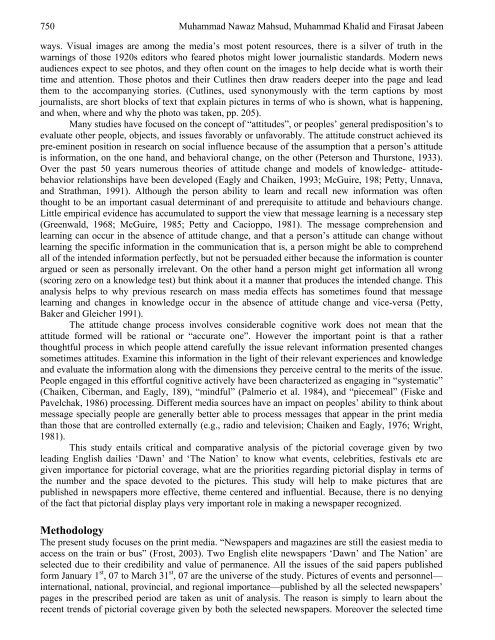European Journal of Scientific Research - EuroJournals
European Journal of Scientific Research - EuroJournals
European Journal of Scientific Research - EuroJournals
You also want an ePaper? Increase the reach of your titles
YUMPU automatically turns print PDFs into web optimized ePapers that Google loves.
750 Muhammad Nawaz Mahsud, Muhammad Khalid and Firasat Jabeen<br />
ways. Visual images are among the media’s most potent resources, there is a silver <strong>of</strong> truth in the<br />
warnings <strong>of</strong> those 1920s editors who feared photos might lower journalistic standards. Modern news<br />
audiences expect to see photos, and they <strong>of</strong>ten count on the images to help decide what is worth their<br />
time and attention. Those photos and their Cutlines then draw readers deeper into the page and lead<br />
them to the accompanying stories. (Cutlines, used synonymously with the term captions by most<br />
journalists, are short blocks <strong>of</strong> text that explain pictures in terms <strong>of</strong> who is shown, what is happening,<br />
and when, where and why the photo was taken, pp. 205).<br />
Many studies have focused on the concept <strong>of</strong> “attitudes”, or peoples’ general predisposition’s to<br />
evaluate other people, objects, and issues favorably or unfavorably. The attitude construct achieved its<br />
pre-eminent position in research on social influence because <strong>of</strong> the assumption that a person’s attitude<br />
is information, on the one hand, and behavioral change, on the other (Peterson and Thurstone, 1933).<br />
Over the past 50 years numerous theories <strong>of</strong> attitude change and models <strong>of</strong> knowledge- attitude-<br />
behavior relationships have been developed (Eagly and Chaiken, 1993; McGuire, 198; Petty, Unnava,<br />
and Strathman, 1991). Although the person ability to learn and recall new information was <strong>of</strong>ten<br />
thought to be an important casual determinant <strong>of</strong> and prerequisite to attitude and behaviours change.<br />
Little empirical evidence has accumulated to support the view that message learning is a necessary step<br />
(Greenwald, 1968; McGuire, 1985; Petty and Cacioppo, 1981). The message comprehension and<br />
learning can occur in the absence <strong>of</strong> attitude change, and that a person’s attitude can change without<br />
learning the specific information in the communication that is, a person might be able to comprehend<br />
all <strong>of</strong> the intended information perfectly, but not be persuaded either because the information is counter<br />
argued or seen as personally irrelevant. On the other hand a person might get information all wrong<br />
(scoring zero on a knowledge test) but think about it a manner that produces the intended change. This<br />
analysis helps to why previous research on mass media effects has sometimes found that message<br />
learning and changes in knowledge occur in the absence <strong>of</strong> attitude change and vice-versa (Petty,<br />
Baker and Gleicher 1991).<br />
The attitude change process involves considerable cognitive work does not mean that the<br />
attitude formed will be rational or “accurate one”. However the important point is that a rather<br />
thoughtful process in which people attend carefully the issue relevant information presented changes<br />
sometimes attitudes. Examine this information in the light <strong>of</strong> their relevant experiences and knowledge<br />
and evaluate the information along with the dimensions they perceive central to the merits <strong>of</strong> the issue.<br />
People engaged in this effortful cognitive actively have been characterized as engaging in “systematic”<br />
(Chaiken, Ciberman, and Eagly, 189), “mindful” (Palmerio et al. 1984), and “piecemeal” (Fiske and<br />
Pavelchak, 1986) processing. Different media sources have an impact on peoples’ ability to think about<br />
message specially people are generally better able to process messages that appear in the print media<br />
than those that are controlled externally (e.g., radio and television; Chaiken and Eagly, 1976; Wright,<br />
1981).<br />
This study entails critical and comparative analysis <strong>of</strong> the pictorial coverage given by two<br />
leading English dailies ‘Dawn’ and ‘The Nation’ to know what events, celebrities, festivals etc are<br />
given importance for pictorial coverage, what are the priorities regarding pictorial display in terms <strong>of</strong><br />
the number and the space devoted to the pictures. This study will help to make pictures that are<br />
published in newspapers more effective, theme centered and influential. Because, there is no denying<br />
<strong>of</strong> the fact that pictorial display plays very important role in making a newspaper recognized.<br />
Methodology<br />
The present study focuses on the print media. “Newspapers and magazines are still the easiest media to<br />
access on the train or bus” (Frost, 2003). Two English elite newspapers ‘Dawn’ and The Nation’ are<br />
selected due to their credibility and value <strong>of</strong> permanence. All the issues <strong>of</strong> the said papers published<br />
form January 1 st , 07 to March 31 st , 07 are the universe <strong>of</strong> the study. Pictures <strong>of</strong> events and personnel—<br />
international, national, provincial, and regional importance—published by all the selected newspapers’<br />
pages in the prescribed period are taken as unit <strong>of</strong> analysis. The reason is simply to learn about the<br />
recent trends <strong>of</strong> pictorial coverage given by both the selected newspapers. Moreover the selected time

















